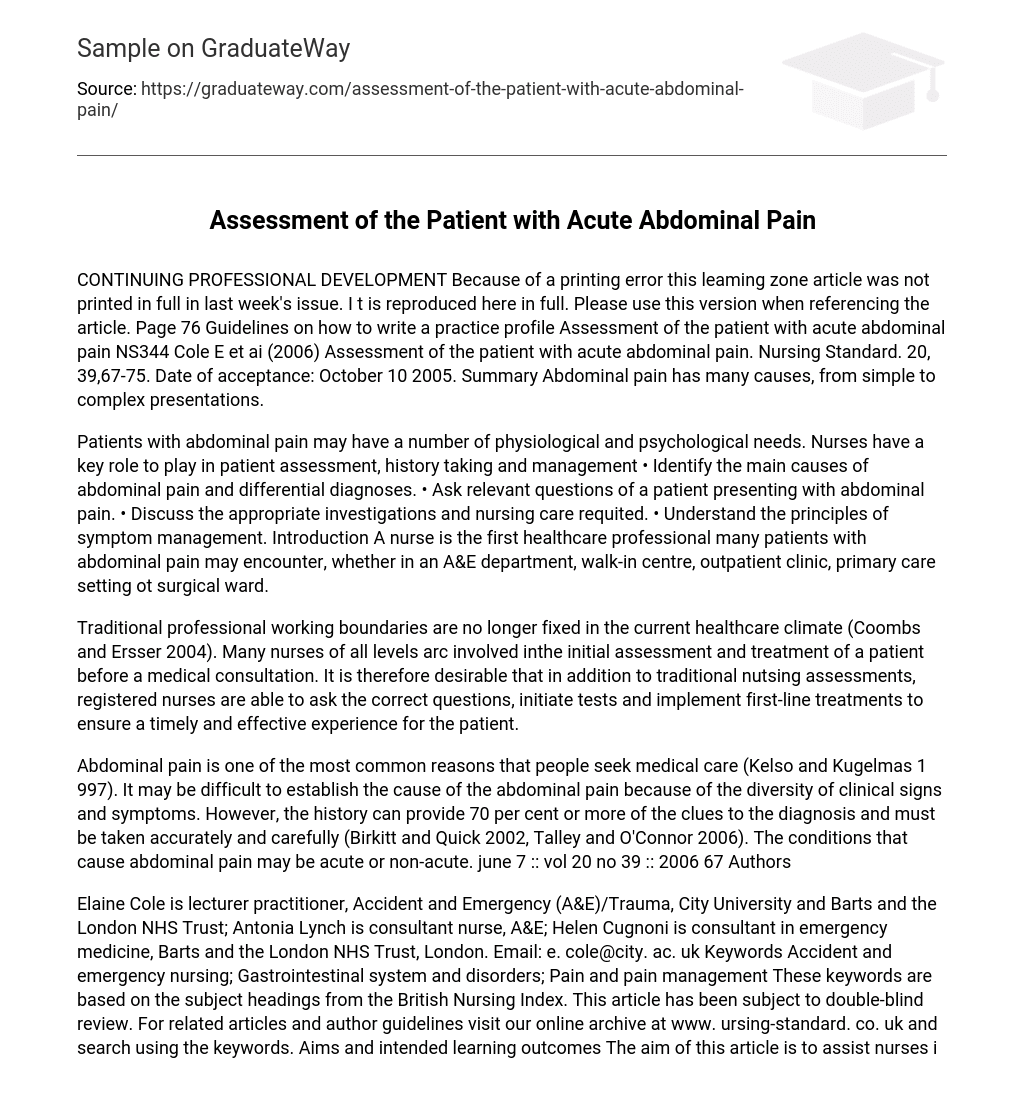Introduction
When patients experience abdominal pain, a nurse is often the first healthcare professional they come across. This encounter can take place in various healthcare settings, including A&E departments, walk-in centres, outpatient clinics, primary care settings, and surgical wards.
In the current healthcare climate, traditional professional working boundaries have become more flexible (Coombs and Ersser 2004). Nurses of all levels now participate in the initial assessment and treatment of patients before a medical consultation. Therefore, it is important for registered nurses to not only conduct traditional nursing assessments but also ask relevant questions, perform necessary tests, and administer first-line treatments. This ensures that the patient receives a timely and effective experience.
When people experience abdominal pain, they often seek medical assistance. Determining the root cause of this pain can be difficult due to the different signs and symptoms it presents. Kelso and Kugelmas (1997) state that gathering a detailed patient history is crucial in diagnosing the condition accurately. In fact, Birkitt and Quick (2002) as well as Talley and O’Connor (2006) suggest that more than 70% of the necessary information for diagnosis can be obtained through an accurate and thorough patient history.
To effectively assess patients with abdominal pain, nurses must possess a thorough knowledge of the abdominal anatomy and be acquainted with the positioning of its organs. In clinical examination, the abdomen is commonly segregated into four quadrants: right upper, left upper, right lower, and left lower (Figure 1). Patients may accurately pinpoint the quadrant where their pain occurs, aiding nurses in gauging any potential association with specific organs or structures.
The lower left quadrant of the abdomen contains organs such as the sigmoid colon and a part of the descending colon. These abdominal organs are surrounded by a membrane known as the peritoneum. The kidneys and ureters, positioned behind these organs, are referred to as retroperitoneal. Any discomfort originating from these structures may be experienced not in the abdomen itself but rather in the loin area, located at the back of the torso between the ribs and hips.
The bladder and reproductive organs are situated in the lower abdomen within the pelvis. It is important to compile a list of these organs and viscera, along with a brief explanation of their functions, before proceeding further. To confirm your answers, consult an anatomy and physiology textbook. About 50% of abdominal symptoms can be alleviated without surgery, particularly pain. The other half of individuals in this category may need immediate or planned surgical intervention while in the hospital (Birkitt and Quick 2002).
According to Longmore et al. (2004), abdominal pain can have different causes, but the most common surgical emergency is appendicitis. Symptoms of appendicitis usually involve colicky pain that starts around the umbilicus or epigastrium.
As the inflammation advances and impacts the peritoneum, it results in pain shifting to the lower right quadrant known as the right iliac fossa. There may also be a decrease in appetite, vomiting, constipation, and sporadic episodes of diarrhea.
Biliary colic pertains to symptoms triggered by periodic obstruction of either the cystic duct or common bile duct due to gallstones. These symptoms frequently manifest in overweight women. The pain typically resembles cramps and is concentrated in both the upper right quadrant and epigastrium while radiating towards the back.
Both the small and large intestines are prone to obstruction, resulting in symptoms such as anorexia, vomiting followed by relief, colicky abdominal pain, and a distended abdomen. Tinkling bowel sounds may sometimes be heard during auscultation, although this is not always the case. Moreover, constipation and the inability to pass stool and gas may also occur due to the blockage.
Abdominal X-ray can confirm the location of the obstruction. Possible causes of large bowel obstruction are impacted faeces, tumours, and volvulus (twisting of the intestine). Small bowel obstruction can be caused by adhesions, Crohn’s disease, tumours, and swallowed foreign bodies. Gall bladder inflammation, known as cholecystitis, is characterized by acute or chronic inflammation mostly caused by mixed chemical composition stones, primarily cholesterol and some bile.
Symptoms can arise from mechanical blockage, local inflammation, or a combination of both (Uphold and Graham 1999). The pain may be colicky or constant and is usually concentrated in the right upper quadrant. Loss of appetite, nausea, vomiting, and fever are common accompanying symptoms. Gastrointestinal illness often requires immediate surgical referral as it can lead to gastrointestinal bleeding characterized by hematemesis (vomiting of blood), rectal bleeding, or melaena (black, ‘tarry’ feces or vomit containing blood) (Birkitt and Quick 2002).
Severe gastrointestinal haemorrhage can be indicated by symptoms such as hypotension, shock, and collapse in patients. The main cause of this condition is peptic ulceration, which is characterized by dyspeptic pain and tenderness in the epigastrium. Vomiting may also be experienced by individuals with a gastric ulcer. Bleeding can also occur due to gastritis, especially after consuming alcohol or non-steroidal anti-inflammatory drugs (NSAIDs). Gastroenteritis resulting from an infection is another source of intestinal inflammation. Symptoms associated with gastroenteritis include diarrhoea, vomiting, and generalised colicky abdominal pain.
Severe cases of the disease may result in patients experiencing pyrexia, dehydration, and systemic illness. It is crucial to emphasize that this disease must be reported.
Differentiating between patients with abdominal pain and those with other conditions in gynaecological emergencies can pose a challenge (Wyatt et al 2005). As mentioned earlier, the patient’s medical history can provide 70% of the necessary information for determining an underlying diagnosis. This encompasses scenarios such as early pregnancy miscarriages, ovarian cysts, and endometriosis.





